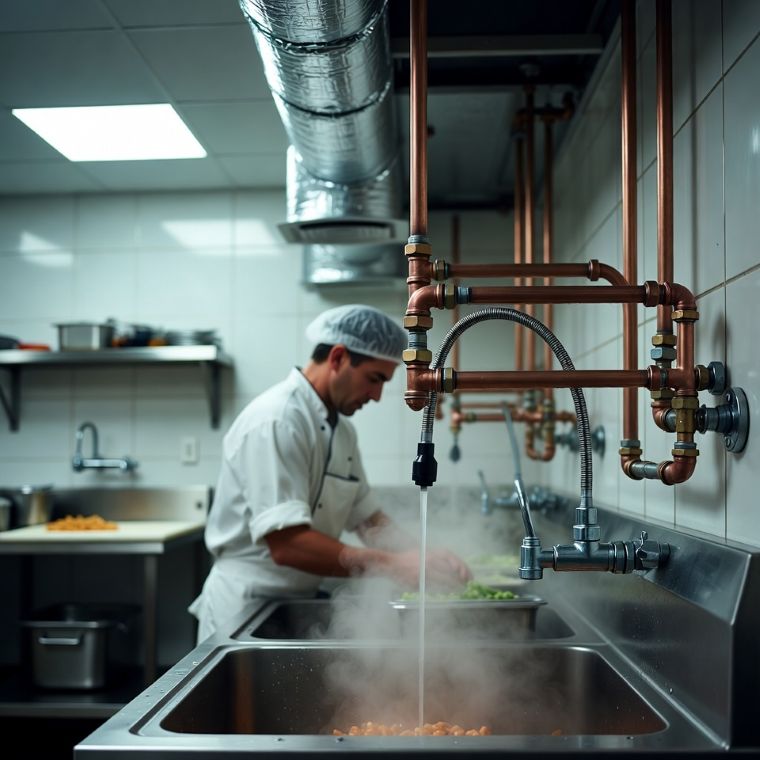
Food service operations depend on a steady flow of hot water, clean air, and controlled temperatures to keep dishes safe and customers happy. Every kitchen, from a small café to a large restaurant, relies on careful coordination between plumbing systems and HVAC units. These two systems shape everything from prep work to sanitation, and they also help staff maintain a safe and productive workspace.
A well designed kitchen needs both reliable water systems and stable heating and cooling to meet daily demands. Many restaurants work with specialists like Frederick MD HVAC professionals to set up temperature control that supports food safety rules and smooth operations. When both systems perform well, kitchens avoid delays, spoilage, and unnecessary stress on staff.
1. Strong Plumbing Supports Safe Food Prep
Food prep areas rely on clean, steady water at the right temperature. Sinks, cutting stations, and handwashing zones need dependable plumbing to stay sanitary. When water pressure is unstable or heaters fail, food safety becomes harder to manage. Proper plumbing ensures that every chef has what they need to prepare ingredients safely and efficiently.
2. Water Heaters Power Daily Sanitation
Dishwashing depends on water heaters that meet strict health code temperatures. Hot water helps remove grease and sanitize surfaces. If heaters fall behind or run too small for the kitchen size, dishes take longer to clean and bacteria become harder to eliminate. Regular inspections and right sized equipment reduce these problems.
3. Drainage Protects Floors and Work Zones
Good drainage keeps floors dry and reduces slip hazards. When drains clog or back up, water can spread across work areas and create contamination risks. Smooth drainage flow helps kitchens maintain a clean environment even during peak hours. This simple detail often makes a big difference in safe operations.
4. HVAC Controls Humidity in Storage Rooms
Humidity is one of the silent threats to stored ingredients. Too much moisture speeds up spoilage, molds, and changes in food quality. HVAC systems, especially high quality ventilation units, help keep cooler rooms and dry storage spaces at ideal conditions. This level of stability supports better storage technology, and resources like how vacuum insulating glass is changing the way we store and serve food and drink give more insight into how controlled environments keep ingredients fresh.
5. Air Circulation Helps Maintain Consistent Temperatures
A strong ventilation setup prevents hot and cold pockets inside the kitchen. Uneven temperatures can affect how ingredients are stored and how staff move around the workspace. Improved air circulation also helps remove heat from cooking equipment, making the entire kitchen safer and more comfortable.
6. Emergency Backup Systems Keep Work Moving
Backup heating and hot water systems protect operations during sudden failures. A broken water heater or HVAC unit can bring service to a halt. Kitchens that have emergency backups stay open even when something goes wrong. A backup system ensures that sanitation and dishwashing continue without delays.
7. Maintaining HVAC Is Key to Food Quality
Well maintained HVAC systems support consistent temperatures for coolers, prep tables, and walk in units. When HVAC systems work smoothly, chefs can trust that ingredients stay fresh. Routine checkups from technicians, including services similar to those offered by Frederick MD HVAC, help prevent breakdowns during busy shifts.
8. Plumbing and HVAC Work Together for Energy Savings
Efficient hot water systems and updated heating or cooling units lower utility costs. Modern commercial kitchens use a large amount of energy each day. Choosing efficient water heaters, paired with upgraded HVAC units, reduces long term operating expenses. Energy savings often come from small but smart upgrades.
9. Combined Upgrades Improve Staff Comfort
A kitchen with good airflow and easy access to hot water supports faster and safer teamwork. Staff move quickly, handle high heat, and work during long shifts. When both systems work well, the kitchen becomes more comfortable, organized, and productive. Comfort plays a major role in consistent food quality.
Conclusion
A kitchen functions best when plumbing and HVAC systems support each other. Clean water, stable temperatures, and strong airflow help maintain food safety and smooth workflow. Restaurants that work with reliable providers like Frederick MD HVAC manage equipment challenges faster and prevent health code issues. When plumbing and HVAC stay in sync, kitchens deliver better food, better safety, and a better working experience for everyone.